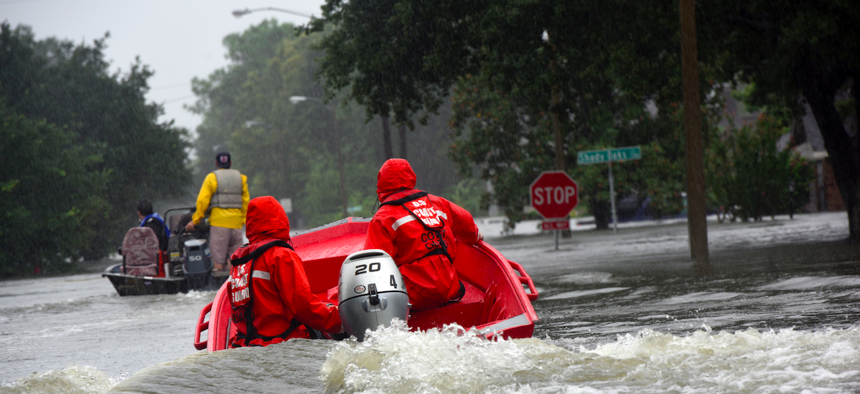
Coast Guard petty officers pilot a 16-foot flood punt boat and join good Samaritans in patrolling a flooded neighborhood in Friendswood, Texas after Hurricane Harvey. Petty Officer 3rd Class Corinne Zilnicki/U.S. Coast Guard
Half of the US Military’s Sites Are Vulnerable to Climate Change. Now What?
Next up: figuring out what bases, airfields, and naval stations need help first, says the former Pentagon appointee who started the survey.
Thanks to the first comprehensive survey of its facilities around the world, the Pentagon now knows that about half of them have been damaged or disrupted by extreme weather at some point. But that’s just a baseline; now the real analysis has to start, says the man who started planning the report back in 2014.
Individual anecdotes abound about how climate change and increasingly extreme weather threaten specific bases, but the qualitative survey released Friday by the Office of the Undersecretary of Acquisition, Technology, and Logistics offers a global snapshot of the 3,500 sites’ recent experiences of flooding, droughts, and other extreme weather. In doing so, it hints at which installations may be affected in the future by changing climates.
The most common types of extreme weather were droughts, damaging high winds, and flooding unrelated to storms — each affected about one-fifth of the sites. Disruption to airfield operations was the most commonly cited effect, followed by impacts on ground transportation and energy infrastructure.
What next?
Now that the department has an idea how widespread the problem is, it needs to figure out which sites merit attention, said John Conger, who launched the survey three years ago when he was the acting assistant defense secretary for energy, installations and environment.
Say climate change drives summer temperatures to record-breaking heights: “Run the air conditioning a few degrees higher,” said Conger, who’s now a fellow at the Center for Climate and Security. “Those aren’t your greatest concerns. The ones you’re really worried about are where are your mission impacts.”
That kind of analysis is beyond the scope of this report, he said.
A Pentagon spokesman acknowledged the threat, and the value of studying it. “A changing climate is a national security issue with potential impacts to missions, operational plans, and installations,” Adam Stump said in an email. “The department's understanding of a changing climate will enable the military services and agencies to continue to execute their missions.”
To get there, Conger said the department would have to link individual events — say, downed power lines from more frequent storms — to their effects on various missions, then rack and stack them against each other.
“Whether it’s wind, storm surge, wildfires, sea-level rise, whatever it is, I want to find some sort of metric to compare them all to each other,” he said. “Then there’s going to be a qualitative filter — that’s not really that severe, this is — then once you’ve got that, what you’re really going to want to do is start doing some mitigation analysis at each location and figure out what steps you can take to address the issue, to buy back the mission days, and to reduce the damage.”
Is there the will?
Defense Secretary Jim Mattis told senators during his confirmation hearings that “the effects of a changing climate...will impact our security situation.” But since entering office, he has been quiet on the topic — in his transcribed public remarks, he hasn’t mentioned “climate change” or “global warming” once.
More concerning to climate activists, the department does not appear to be prioritizing it the way the former administration did. The 2014 Quadrennial Defense Review mentioned “climate change” and discussed the threats posed or exacerbated by it eight times; the 2015 National Security Strategy listed “confront climate change” as a security priority. Neither the recent NSS nor the National Defense Strategy mention it once — an omission that drew a Jan. 11 letter of protest from a bipartisan group of more than 100 lawmakers. Nor did the commander-in-chief mention climate change in Tuesday’s State of the Union address.
The Pentagon says it still views climate change as potential threat, just not one of the highest-priority ones.
“There are many, many priorities to the department, but we had to distill them into that critical few,” Deputy Defense Secretary Pat Shanahan said in December when asked about the strategies. “So it doesn't mean that it's not a priority, or that it is a priority. What it says is, in the National Defense Strategy, we don't address it.”
But the next step is already on the horizon, thanks to Congress: The 2018 National Defense Authorization Act requires the Pentagon to identify the 10 most vulnerable military installations by service and the mitigations it could take to safeguard military resiliency. The provision isn’t as strong a stance as lawmakers took on cyber or space policy, but it’s a step.
“When we’re talking about the fact that the National Security Strategy doesn’t have climate change in it, it isn’t like hitting the brakes, but it is kind of like taking your foot off the accelerator,” Conger said. “Congress is pulling now. They pulled this report. They’re pulling the next report already...the center has shifted.”




